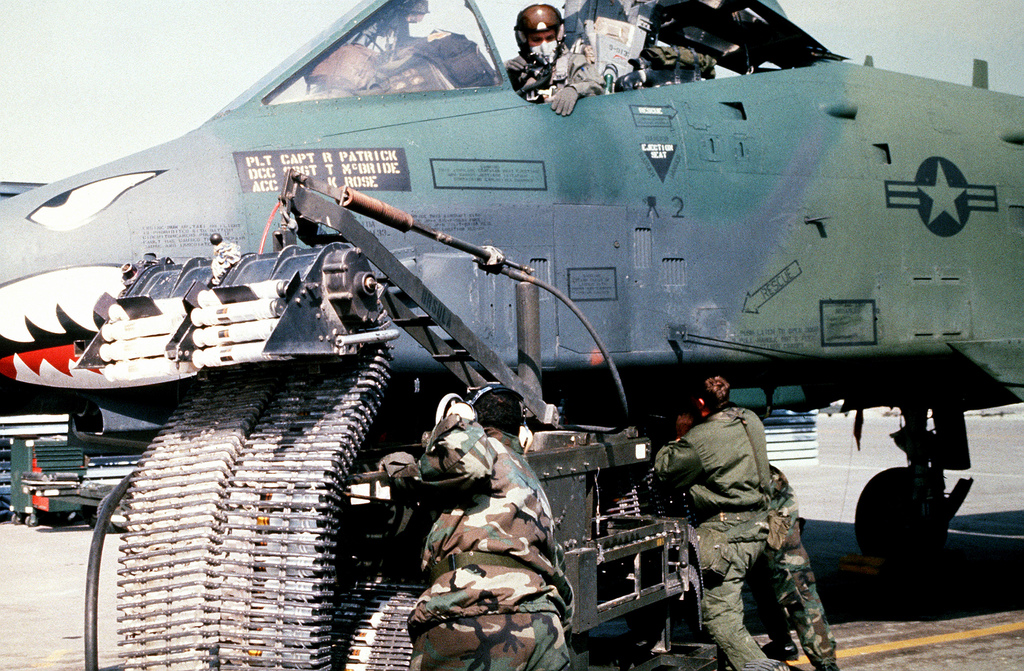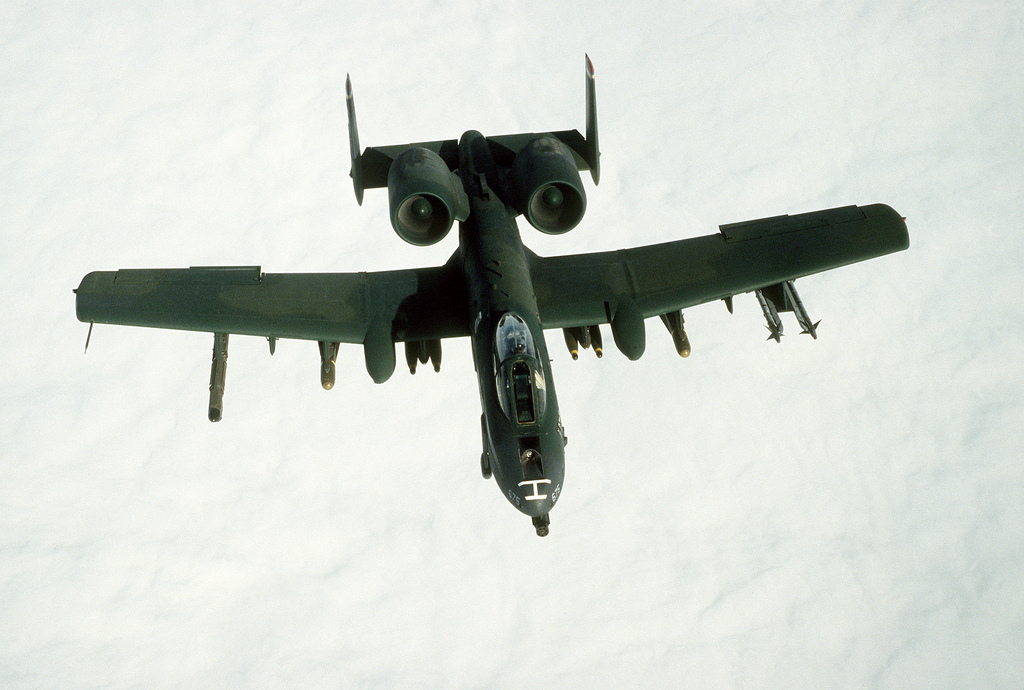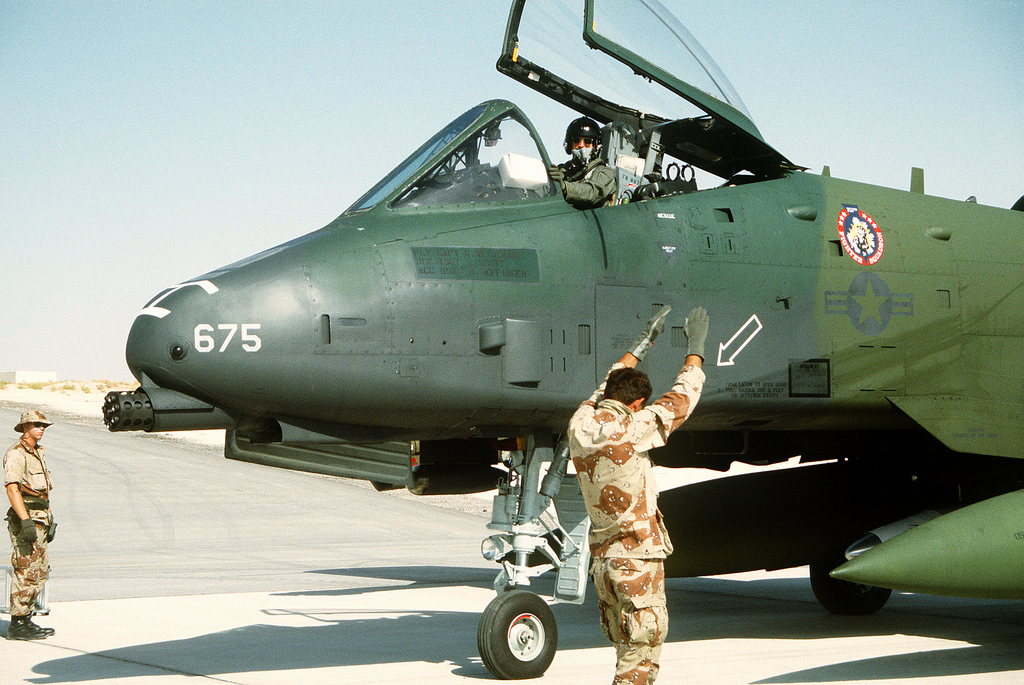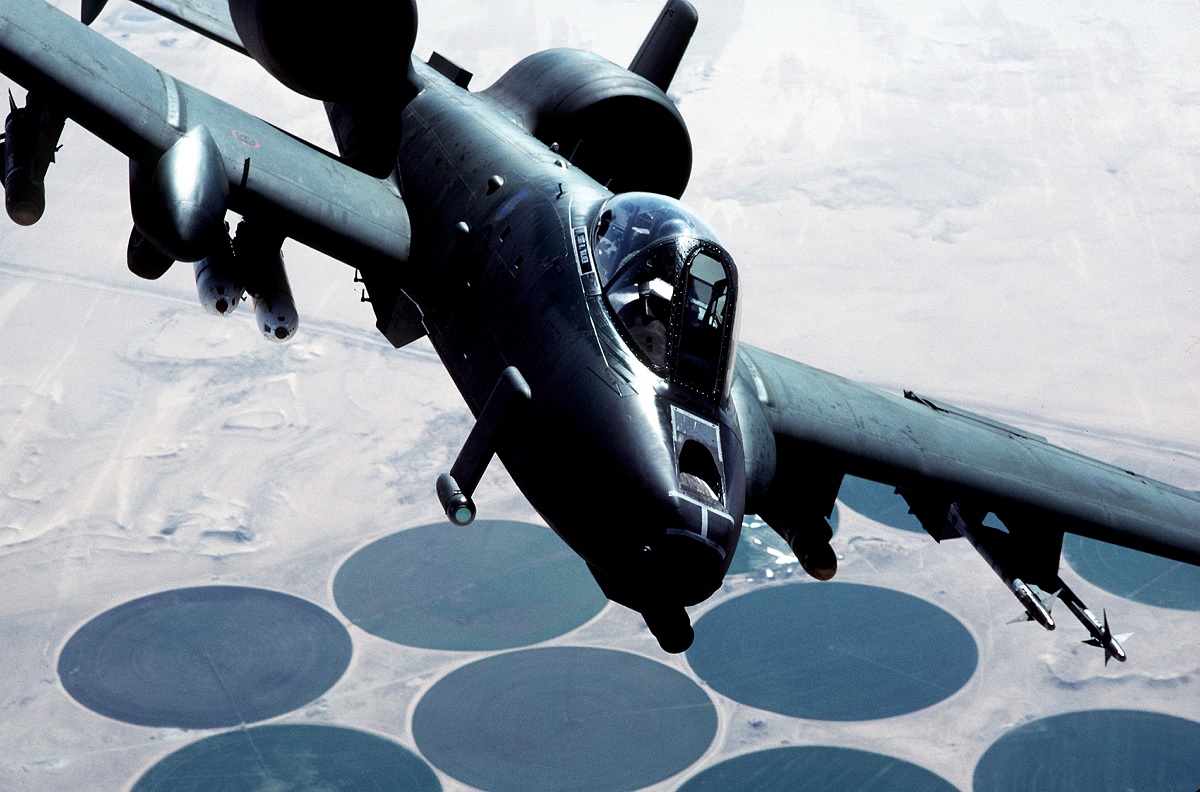“I put another 100 rounds down, and the helicopter jinked right into the last burst; the helicopter looked like it had been hit by a bomb,” Capt. Robert “Swaino” Swain, A-10 pilot
The Fairchild Republic A-10 Thunderbolt II was built for quick-response support against enemy ground forces, close air support (CAS) of friendly ground forces, and attacking tanks and armored vehicles. It was the only production-built aircraft used by the U.S. Air Force (USAF) that was created specifically for CAS, and it entered service in 1976. By guiding other aircraft in strikes on ground targets, it supports forward air controllers airborne (FAC-A). OA-10 is the designation for aircraft used primarily in this role.
During Operation Desert Storm in 1991, the A-10 saw its first employment in actual combat, resulting in the destruction of more than 900 Iraqi tanks, 2,000 other military vehicles, and 1,200 pieces of artillery. With their powerful GAU-8/A Avenger cannon, the A-10s also brought down two Iraqi helicopters during the campaign.
Capt. Robert “Swaino” Swain of the 706th Tactical Fighter Squadron (TFS) shot down an Iraqi Bo-105 helicopter while flying the A-10A No. 77-0205 on February 6. This was the first A-10 air-to-air victory. As explained by Donald J. McCarthy, Jr. in his book “The Raptors All F-15 and F-16 aerial combat victories,” Swain (call-sign SAVAGE 01) had just attacked two Iraqi tanks with Maverick missiles in central Kuwait when he observed strange movement some distance from his position. He recalls: “They weren’t putting up any dust and were moving fast over the desert.”

White phosphorus (WP) rocket was used by one of the coalition’s FAC-As to mark the ground, which assisted everyone else to focus on the targets.
In Craig Brown’s book Debrief: a complete history of U.S. aerial engagements 1981 to the present, Swain describes how the air engagement occurred: “I decided to get a close look, and tried to get a visual identification by over-flying the two helicopters at 5-6,000 feet. They must have seen me because then they split up and started taking evasive maneuvers. The one helicopter to the north broke away and headed to a known Iraqi police station/camp, while the other continued southwest. Once it was determined that there were no known friendlies in the area and that one of the helicopters flew to a known enemy site, I determined that the remaining flying helicopter was also a bandit, and decided to destroy it. I gave the first shot to my wingman, Lt White, but his slant range was beyond two miles, and he misjudged his shot and missed. I then decided that, since I was overhead the target, I would take a shot. I armed my gun but also un-caged my AIM-9 heat-seeking missile. I was fairly steep (65-70 degrees), and tried to lock up the helicopter twice, but the missile kept breaking the lock because of the size of the target, distance away, and the surrounding terrain. Prior to pulling off the target I decided to also shoot the gun and put about 75 rounds out, but thought I had missed. I then extended away from the target and tried a second pass. I noticed that the helicopter was flying erratically, but I still managed to miss to the left with my first burst of 100 rounds, retook aim, fired another 100 rounds, and missed right. Knowing I was pressing the minimum altitude for the kill box, I put another 100 rounds down, and the helicopter jinked right into the last burst; the helicopter looked like it had been hit by a bomb.”
A-10A No. 81-0964 pilot Capt. Todd “Shanghai” Sheehy of the 511th TFS repeated this on February 15 when he used his Avenger to bring down a Mi-8. McCarthy claims that Sheehy (call-sign SPRINGFIELD 27) discovered the “Hip” in his operational area while flying his twenty-seventh combat sortie close to the highly protected city of Karbala. Shanghai responded swiftly and used his 30 mike-mikes to engage the Iraqi aircraft.
Sheehy describes to Brown the way he handled the engagement: “Things were happening fast; the helicopter moving quickly across my canopy, the altimeter unwinding and approaching 8,000 feet, and the potential threat all distracting me as I settled the gun cross out in front of the target.
No friendly helos would be in this area, I thought.
What about the AIM-9? No, the desert sand is probably hotter than the target-it’s good gunshot.
I can see it pretty clearly now… Man, that IS an enemy helicopter-looks like a Mi-8 “Hip” with rocket pods… Pull the trigger!
As my heart pounded in my chest and all these thoughts surged through my mind I was pulling the trigger. The gun was firing, but it seemed distant. Suddenly the distortion of time and space stopped, and I fully realized what was happening; the altitude in the HUD was rapidly passing five thousand feet as I came off the trigger and pulled and jinked to the right, away from the big guns [Sheehy had been shot in the same area two days before by 23, 37, and 57mm AAA].

‘Looks like the second half of the burst got it,” Jay [First Lieutenant Jay Keller of the 76th TFS, who was Sheehy wingman for that mission] reported excitedly, as I jinked for all I was worthwhile aware of all the small white ‘clouds’ of exploding AAA around my canopy.
[…] I quickly asked COUGAR [the AWACS call sign) if he had any further contacts, to which he answered me negative. I then told him I had found the contact, as I got my first look at the target since rolling in and pulling the trigger. Through the smoke and dust, it appeared to still be intact and flying, although more slowly than before, and trailing thin white smoke.
‘Was that a helicopter?” Jay asked. ‘Ya,’ I answered curtly, realizing I needed to attack again quickly before I got behind a battery of 23mm guns whose revetments and muzzle flashes I could see clearly from my relatively low altitude. ‘One’s back in,’ I transmitted, rolling in from 8,000 feet. ‘Last pass,’ I added […].
As I rolled in again, I was keenly aware of my low altitude and my proximity to the threat. I rolled out quickly and took aim, leading the helicopter more than during the last pass. I squeezed the trigger again, and as I watched the helicopter fly through the bullets I realized the ground was coming up fast. As I took in the altitude readout on the HUD, the gun suddenly stopped.

Did I let off the trigger? I briefly wondered. Er!! 4,000 feet… Climb now!!
Again, I pulled hard and rolled to the right. Jinking. I climbed. My lungs were straining to pull in enough air as I labored to breathe under the G forces, which pulled at every part of me. I climbed away to the west, twisting and slipping my jet through the sky with the 23mm AAA airbursts trailing behind. Somewhere in the distance, I heard Jay proclaim ‘Great hits!!’ 8,000 feet, I eased off the G and looked over my shoulder at the target. It was gone. In its place a ball of flame and thick, black smoke. Many emotions went through me that instant: excitement, pain, fear, relief, and pride all at once.
[…] I had just become only the second A-10 pilot in history to score an air-to-air kill, and one of the very few pilots in modern history to do so with a gun rather than missiles.”
This marks not just the final A-10 air-to-air kill, but also the final gun kill by US forces.
Debrief: a complete history of U.S. aerial engagements 1981 to the present is published by Osprey Publishing and is available to order here.

Photo by U.S. Air Force

